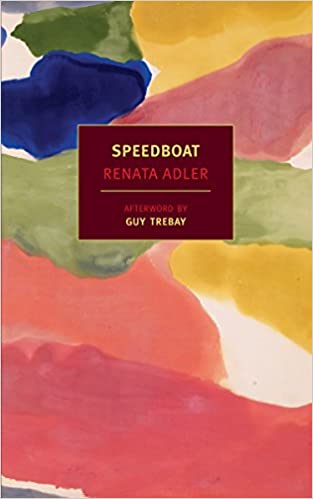
by Michael Loveday
The ‘classic-form’ novella-in-flash described in the previous part of this essay might be the central role model, but here are some other creatures within the overall family:
The Novella-in-Fragments
Some novella-in-flash-style texts consist of a continuously broken stream of fragments rather than a set of self-contained stories. The text is shattered into moments that are very brief – sometimes only one or two sentences long – and in each section there is no attempt to set up a full short-short story with a title and a beginning, middle, and end. The text is more like a series of shards or splinters – as if the writer has taken the vase of a story situation and smashed it to pieces. Even more so than usual, the feeling of narrative is built up through accumulated glimpses of a whole, rather than by moving through a series of clearly staked out scenes. Blank space appears frequently on the page, but only briefly before more sentences appear in short bursts – suggesting continuity and fragmentation at the same time. A unifying character situation often emerges, and readers’ investment in this central situation is what carries them willingly through the fragments. In some of these books, the fragments are bewilderingly different: aphorisms, quotations, and non-fiction extracts spark up against the fiction itself, enriching the story’s themes and forcing the reader to make leaps of connection (cf. Renata Adler’s Speedboat (1976), and Jenny Offill’s Dept. of Speculation (2014)). In others, the material is mostly continuous, and the apparent brokenness of the stream is simply the visual result of the book using clear spaces between short paragraphs that aren’t indented. (Cf. Clarice Lispector’s Agua Viva (1973), Megan Hunter’s The End We Start From (2017), and Cynan Jones’s The Dig (2014) and Cove (2016)). The novella-in-fragments is an important relative of the novella written in full-fledged flash fictions, since the fragments sometimes read like individual microfictions.
Other relevant examples in this category include Jenny Offil’s Weather (2020); Mary Robison’s Why Did I Ever (2001) and One D.O.A., One on the Way (2009) which add numbers and occasionally titles to their splinters of story; Renata Adler’s Pitch Dark (1983), which adopts some of the same techniques as Speedboat; Marguerite Duras’s The Lover (1984), which is a stream of sometimes haphazard, sometimes continuous short reminiscences; and the bursts of information in the character studies of Bernardine Evaristo’s Booker Prize-winning novel Girl, Woman, Other (2019). All of these books in differing ways make use of a continuously breaking stream of fragments.
The Novella-in-Prose-Poems
Sometimes a novella-in-flash can feel more like a sequence of prose poems than of stories. Compared to a typical flash fiction, prose poetry may be more interested in ideas than story, or may take more frequent flights into poetic devices such as metaphor, sensory images, or musicality. Writing a ‘poem in prose’ is a hybrid, odd thing: a bit like rubbing circles on your stomach while trying to pat the top of your head. A prose poem’s language is part of its primary agenda – as with verse poetry, the language may be calling attention to itself. The sentences and paragraphs shape the music and rhythm as a line break does in a verse poem. But some narrative prose poems mix plainer language and more poetic language, sharing qualities with flash fiction. There is therefore a grey area between the two forms. (The ‘narrative prose poetry’ territory of writers such as Russell Edson, Ian Seed and Carrie Etter is therefore not so far removed from the ‘microfiction’ territory of writers such as Robert Scotellaro and Meg Pokrass.) Naming that territory partly depends on what label the writer wants to use, and how they intend the work to be received. Narrative prose poems may include juxtapositions, omissions, leaps and shifts that require the reader to pay closer attention, and their endings can sometimes seem ‘incomplete’ to the typical flash fiction reader, missing that story shift or closure that’s more common in flash fiction. For me, one of the keys to distinguishing between prose poetry and flash fiction is the degree to which each piece requires a second reading before it can be fully experienced – a prose poem in some way demands that you read it again before it fully unlocks all its riches.
Some novellas-in-prose-poems provide a clear, developing story that is ongoing throughout the book. Others resemble more closely a rich miscellany, as also occurs in the ‘novella-as-collection’ category (see the third part of this essay). The more that a novella-in-prose-poems establishes a distinct set of characters, moving, speaking and interacting through the passage of time, with a narrative shift taking place by the end, then the more it will read like a novella-in-flash.
Books and pamphlets using such techniques include the following: Juan Ramón Jiménez’s Platero and I (1917); Heather Cousins’s Something in the Potato Room (2009); Jennifer Copley’s Mr Trickfeather (2012); Martina Evans’s Petrol (2012); Max Porter’s Grief is the Thing with Feathers (2015); Vanessa Gebbie Ed’s Wife and Other Creatures (2015); and Luke Kennard’s The Solex Brothers (Redux) and Other Prose Poems (2005) and Notes on the Sonnets (2021).
We’ll continue next time by identifying two other kinds of sub-category within the novella-in-flash family.
___________________________
 Michael Loveday is an editor, mentor, and tutor in Adult and Higher Education. He was judge of the 2019 and 2020 Novella-in-Flash Awards at Bath Flash Fiction. He teaches an online course in writing a novella-in-flash: https://novella-in-flash.com/
Michael Loveday is an editor, mentor, and tutor in Adult and Higher Education. He was judge of the 2019 and 2020 Novella-in-Flash Awards at Bath Flash Fiction. He teaches an online course in writing a novella-in-flash: https://novella-in-flash.com/
This article is an extract from his craft guide Unlocking the Novella-in-Flash: from Idea to Manuscript, forthcoming from Ad Hoc Fiction in spring 2022: https://adhocfiction.com/
Grateful acknowledgement to Meg Pokrass, Michelle Elvy, Dave Swann and Anne Caldwell for advice in the development of this essay. This essay was supported using public funding by the National Lottery through Arts Council England.


 The core workshop of SmokeLong Fitness is all in writing, so you can take part from anywhere at anytime. We are excited about creating a supportive, consistent and structured environment for flash writers to work on their craft in a community. We are thrilled and proud to say that our workshop participants have won, placed, or been listed in every major flash competition. Community works.
The core workshop of SmokeLong Fitness is all in writing, so you can take part from anywhere at anytime. We are excited about creating a supportive, consistent and structured environment for flash writers to work on their craft in a community. We are thrilled and proud to say that our workshop participants have won, placed, or been listed in every major flash competition. Community works.